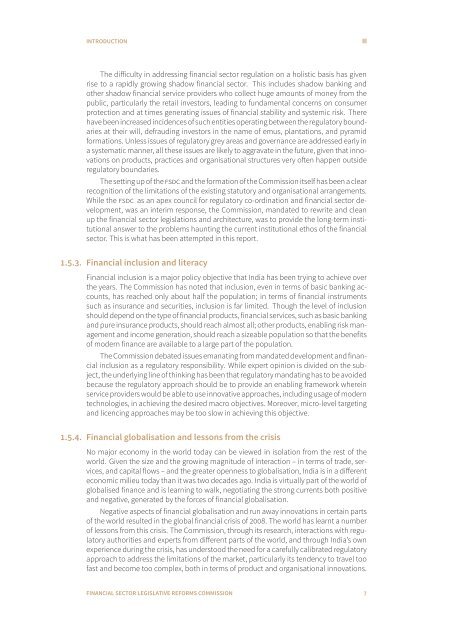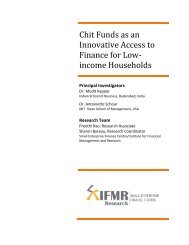Government of India Volume I: Analysis and Recommendations
Government of India Volume I: Analysis and Recommendations
Government of India Volume I: Analysis and Recommendations
You also want an ePaper? Increase the reach of your titles
YUMPU automatically turns print PDFs into web optimized ePapers that Google loves.
INTRODUCTION<br />
The difficulty in addressing financial sector regulation on a holistic basis has given<br />
rise to a rapidly growing shadow financial sector. This includes shadow banking <strong>and</strong><br />
other shadow financial service providers who collect huge amounts <strong>of</strong> money from the<br />
public, particularly the retail investors, leading to fundamental concerns on consumer<br />
protection <strong>and</strong> at times generating issues <strong>of</strong> financial stability <strong>and</strong> systemic risk. There<br />
have been increased incidences <strong>of</strong> such entities operating between the regulatory boundaries<br />
at their will, defrauding investors in the name <strong>of</strong> emus, plantations, <strong>and</strong> pyramid<br />
formations. Unless issues <strong>of</strong> regulatory grey areas <strong>and</strong> governance are addressed early in<br />
a systematic manner, all these issues are likely to aggravate in the future, given that innovations<br />
on products, practices <strong>and</strong> organisational structures very <strong>of</strong>ten happen outside<br />
regulatory boundaries.<br />
The setting up <strong>of</strong> the FSDC <strong>and</strong> the formation <strong>of</strong> the Commission itself has been a clear<br />
recognition <strong>of</strong> the limitations <strong>of</strong> the existing statutory <strong>and</strong> organisational arrangements.<br />
While the FSDC as an apex council for regulatory co-ordination <strong>and</strong> financial sector development,<br />
was an interim response, the Commission, m<strong>and</strong>ated to rewrite <strong>and</strong> clean<br />
up the financial sector legislations <strong>and</strong> architecture, was to provide the long-term institutional<br />
answer to the problems haunting the current institutional ethos <strong>of</strong> the financial<br />
sector. This is what has been attempted in this report.<br />
1.5.3. Financial inclusion <strong>and</strong> literacy<br />
Financial inclusion is a major policy objective that <strong>India</strong> has been trying to achieve over<br />
the years. The Commission has noted that inclusion, even in terms <strong>of</strong> basic banking accounts,<br />
has reached only about half the population; in terms <strong>of</strong> financial instruments<br />
such as insurance <strong>and</strong> securities, inclusion is far limited. Though the level <strong>of</strong> inclusion<br />
should depend on the type <strong>of</strong> financial products, financial services, such as basic banking<br />
<strong>and</strong> pure insurance products, should reach almost all; other products, enabling risk management<br />
<strong>and</strong> income generation, should reach a sizeable population so that the benefits<br />
<strong>of</strong> modern finance are available to a large part <strong>of</strong> the population.<br />
The Commission debated issues emanating from m<strong>and</strong>ated development <strong>and</strong> financial<br />
inclusion as a regulatory responsibility. While expert opinion is divided on the subject,<br />
the underlying line <strong>of</strong> thinking has been that regulatory m<strong>and</strong>ating has to be avoided<br />
because the regulatory approach should be to provide an enabling framework wherein<br />
service providers would be able to use innovative approaches, including usage <strong>of</strong> modern<br />
technologies, in achieving the desired macro objectives. Moreover, micro-level targeting<br />
<strong>and</strong> licencing approaches may be too slow in achieving this objective.<br />
1.5.4. Financial globalisation <strong>and</strong> lessons from the crisis<br />
No major economy in the world today can be viewed in isolation from the rest <strong>of</strong> the<br />
world. Given the size <strong>and</strong> the growing magnitude <strong>of</strong> interaction – in terms <strong>of</strong> trade, services,<br />
<strong>and</strong> capital flows – <strong>and</strong> the greater openness to globalisation, <strong>India</strong> is in a different<br />
economic milieu today than it was two decades ago. <strong>India</strong> is virtually part <strong>of</strong> the world <strong>of</strong><br />
globalised finance <strong>and</strong> is learning to walk, negotiating the strong currents both positive<br />
<strong>and</strong> negative, generated by the forces <strong>of</strong> financial globalisation.<br />
Negative aspects <strong>of</strong> financial globalisation <strong>and</strong> run away innovations in certain parts<br />
<strong>of</strong> the world resulted in the global financial crisis <strong>of</strong> 2008. The world has learnt a number<br />
<strong>of</strong> lessons from this crisis. The Commission, through its research, interactions with regulatory<br />
authorities <strong>and</strong> experts from different parts <strong>of</strong> the world, <strong>and</strong> through <strong>India</strong>’s own<br />
experience during the crisis, has understood the need for a carefully calibrated regulatory<br />
approach to address the limitations <strong>of</strong> the market, particularly its tendency to travel too<br />
fast <strong>and</strong> become too complex, both in terms <strong>of</strong> product <strong>and</strong> organisational innovations.<br />
FINANCIAL SECTOR LEGISLATIVE REFORMS COMMISSION 7



